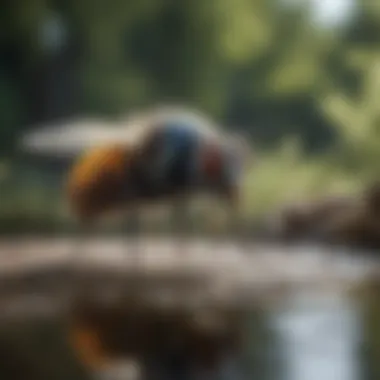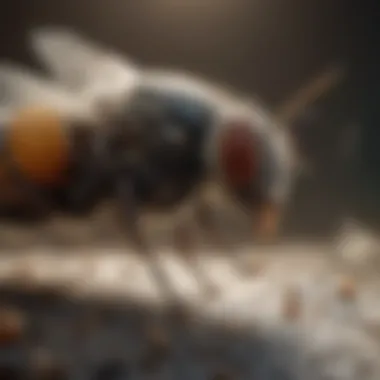Proven Methods to Effectively Eradicate a Large Population of Flies


Animal Species Profile
When addressing the issue of decreasing a large population of flies, it is crucial to understand the common fly species that may infest our surroundings. Flies, belonging to the order Diptera, are known for their adaptability and rapid reproduction rates. Their small size and agility enable them to evade various eradication methods. Flies typically have a slender body with a single pair of wings, large compound eyes, and mouthparts designed for feeding on organic matter. These pests thrive in diverse environments worldwide, from urban areas to rural settings, making them a challenging nuisance to eradicate. Apart from being carriers of diseases, flies exhibit social behaviors, congregating around food sources and communicating through pheromones. Understanding the behavior and biology of flies is imperative in effectively eliminating their population.
Strategies for Fly Control
In the quest to eliminate a significant number of flies, employing a multifaceted approach yields the best results. Prevention is paramount in fly control, starting with sanitation practices to reduce attractants like uncovered garbage and decaying organic materials. Implementing physical barriers such as screens on doors and windows can significantly impede fly entry into living spaces. Moreover, utilizing natural repellents like essential oils or vinegar-based sprays can deter flies without harsh chemicals. For severe infestations, targeted solutions such as fly traps or insecticides can effectively reduce fly populations. It is essential to rotate control methods regularly to prevent flies from developing resistance. By combining preventive measures with targeted interventions, individuals can successfully combat fly infestations and maintain a hygienic environment.
Promoting a Pest-Free Environment
Creating a pest-free environment involves consistency and diligence in applying fly control strategies. Regular monitoring of fly activity is crucial to assess the effectiveness of control measures and identify areas requiring additional attention. Educating oneself on the lifecycle of flies and their preferred breeding sites enables proactive prevention measures. Adequate waste management and proper disposal of organic waste play a pivotal role in reducing fly attraction to properties. Sealing entry points and repairing screens and doors prevent fly intrusion, minimizing the need for extensive control measures. By fostering a clean and hygienic environment, individuals can significantly reduce fly populations and enhance overall quality of life.
Conclusion
Understanding Fly Behavior
Understanding fly behavior plays a crucial role in effectively controlling fly populations. By delving into the intricacies of how flies behave, individuals can implement targeted strategies to combat infestations. This section sheds light on the nuances of fly behavior, emphasizing the significance of identifying key behavioral patterns and tendencies. Through a comprehensive understanding of fly behavior, readers can proactively address infestation issues, thereby creating a more habitable environment.
Identifying Fly Species
Differentiating between common fly species
Distinguishing between common fly species is essential for tailoring effective control methods. Each fly species showcases distinct characteristics that influence their behavior and preferences. By accurately discerning between different fly species, individuals can deploy precise extermination techniques that target specific vulnerabilities. This strategic approach enhances the overall efficacy of fly control measures, minimizing the chances of recurrent infestations. Emphasizing the importance of species identification in fly management showcases a proactive stance towards achieving long-term pest control goals.
Understanding the habits and preferences of flies
Understanding the habits and preferences of flies provides valuable insights into their lifecycle and habitat requirements. By grasping the behavioral patterns of flies, individuals can anticipate potential breeding sites and implement preventive measures effectively. This knowledge allows for the development of proactive strategies that disrupt fly activities and deter infestations. Recognizing the significance of habits and preferences in fly control empowers individuals to create inhospitable environments, reducing the likelihood of widespread infestations. Leveraging this understanding optimizes the efficacy of fly management efforts, fostering a pest-free setting.


Exploring Breeding Sites
Locating potential breeding grounds for flies
Locating potential breeding grounds is a critical step in eradicating fly populations at their source. By identifying areas conducive to fly reproduction, individuals can target these sites for intervention. Implementing measures to eliminate breeding grounds interrupts the lifecycle of flies, curbing population growth significantly. This proactive approach aims to prevent future infestations by addressing the root cause of fly proliferation. Heightening awareness about locating breeding sites underscores the importance of proactive pest management practices in achieving sustainable results.
Implementing measures to disrupt breeding cycles
Implementing strategies to disrupt breeding cycles is key to long-term fly control. By deploying tactics that hinder the reproductive processes of flies, individuals can impede population expansion effectively. This proactive approach minimizes the emergence of new flies, gradually reducing overall population densities. The implementation of targeted measures to disrupt breeding cycles reflects a strategic and methodical approach towards sustainable pest control. Emphasizing the role of intervention in breaking the breeding cycle reinforces the commitment to creating fly-free environments through comprehensive management strategies.
Implementing Preventive Measures
In the grand scheme of eradicating a large populace of flies, implementing preventive measures stands as a fundamental pillar to curb infestations effectively. By taking proactive steps to deter flies from establishing habitats, individuals can significantly reduce the likelihood of infestations within their living spaces. Preventive measures encompass various strategies aimed at disrupting the breeding cycles and foraging patterns of these pesky insects. Whether through maintaining cleanliness, securing entry points, or utilizing natural repellents, each approach plays a crucial role in mitigating the presence of flies within a habitat.
Maintaining Cleanliness
Developing proper waste management practices
One of the cornerstone elements in the battle against fly populations is the establishment of appropriate waste management protocols. This strategic maneuver involves implementing efficient waste disposal methods that eliminate potential food sources for flies, thereby reducing their attractiveness to a habitat. Adequate waste management not only hampers the proliferation of flies but also contributes to creating a hygienic living environment. The key characteristic of developing proper waste management practices lies in its proactive nature, preempting the conditions conducive to fly breeding. Though it requires diligence and regular maintenance, this practice proves itself as a popular choice due to its effectiveness in minimizing fly infestations. Despite the labor-intensive nature of this approach, the advantages it offers in terms of pest control and sanitation within a space make it a paramount consideration in combating fly populations.
Regularly cleaning and sanitizing living spaces
Another vital aspect of implementing preventive measures involves regular cleaning and sanitization of living areas to deter flies from loitering and reproducing. By maintaining clean surroundings and disinfecting commonly frequented spaces, individuals can deprive flies of suitable breeding grounds, disrupting their life cycle. The unique feature of this practice lies in its dual function of minimizing fly attraction and promoting overall hygiene. While the consistent upkeep required may pose a challenge to some, the benefits of reduced fly presence and improved quality of life justify the effort involved. This practice, although necessitating constant attention, maintains its significance in ensuring a fly-free environment, making it a valuable inclusion in the battle against fly infestations.
Securing Entry Points
Sealing cracks and openings to prevent fly intrusion
A critical component of preventive measures against flies entails the sealing of cracks and openings that serve as potential entry points for these pests. By identifying and effectively sealing off these access pathways, individuals can markedly reduce the chances of fly intrusion into their living spaces. The key characteristic of sealing cracks and openings lies in its ability to create a barrier that hinders fly infiltration, thereby safeguarding the premises from infestations. This method proves popular for its simplicity and efficacy in blocking fly entry. However, it may pose minor disadvantages in terms of initial time investment and the need for meticulous inspection to ensure thorough coverage. Overall, the advantages of preventing fly access through this method significantly outweigh any drawbacks, making it an indispensable strategy in fly control.


Installing protective screens on windows and doors
In conjunction with sealing cracks, installing protective screens on windows and doors offers an added layer of defense against fly incursion. These screens act as physical barriers that prevent flies from entering while allowing for ventilation and natural light. A notable characteristic of protective screens is their ability to offer unobtrusive protection, blending seamlessly into the architectural aesthetics of a structure. This unobtrusiveness and functionality make them a popular choice in fly deterrence measures. Despite the initial cost involved, the benefits of maintained airflow, natural light, and enhanced fly protection outweigh any minor inconveniences. Thus, the installation of protective screens serves as a practical and effective strategy in fortifying living spaces against fly infestations.
Utilizing Natural Repellents
Investigating natural ingredients with repelling properties
An exploration of natural ingredients with insect-repelling properties unveils a realm of possibilities for deterring flies from infesting living spaces. By researching and identifying natural substances that flies find aversive, individuals can formulate potent repellents that drive these pests away. The key characteristic of investigating natural ingredients with repelling properties lies in its ecological and health-friendly approach, steering clear of harmful chemicals often present in conventional insecticides. This eco-conscious method proves popular among environmental enthusiasts and health-conscious individuals for its non-toxic nature. However, potential disadvantages may include variability in repellent efficacy and the need for periodic reapplication to maintain effectiveness. Despite these considerations, the advantages of natural repellents in promoting a safe living environment and minimizing chemical exposure render them a compelling choice in fly control strategies.
Creating DIY repellent solutions
For those inclined towards a hands-on approach, creating do-it-yourself (DIY) repellent solutions presents an engaging and cost-effective means of combating fly populations. Through simple yet innovative concoctions using natural ingredients, individuals can craft bespoke repellents tailored to their specific needs and preferences. The unique feature of DIY repellent solutions lies in their customizable nature, allowing for experimentation with various ingredients to optimize repellent potency. This customization aspect appeals to DIY enthusiasts and individuals seeking customizable pest control solutions. While DIY solutions require time and effort for preparation, their advantages such as affordability and control over ingredient quality make them an attractive option for those looking to tackle fly infestations sustainably.
Effective Fly Extermination Techniques
In the realm of pest control, one of the most critical focuses is on Effective Fly Extermination Techniques. Flies are not only a nuisance but also carriers of diseases, necessitating the eradication of these pests. In this article, the emphasis on implementing efficient fly control methods underscores the significance of maintaining a healthy environment. The particular attention on effective techniques highlights proactive measures to combat infestations and ensure the well-being of inhabitants.
Using Commercial Insecticides
Selecting appropriate insecticides for fly control:
When it comes to mitigating fly populations, the selection of suitable insecticides plays a pivotal role. Choosing the right insecticide is crucial for achieving optimal results in pest elimination. The key characteristic of selecting appropriate insecticides lies in their ability to target flies specifically while minimizing harm to other beneficial organisms. This prudent choice not only ensures effective pest control but also aligns with environmental conservation goals. By highlighting the targeted action of these insecticides, the article aims to provide readers with a comprehensive understanding of their role in fly mitigation.
Applying insecticides safely and effectively:
In the application of insecticides for fly control, safety and efficacy are paramount considerations. Ensuring that insecticides are applied correctly guarantees their desired impact on fly populations while safeguarding human and environmental health. The key characteristic of safe application methods lies in following manufacturer instructions diligently to prevent adverse effects. This approach not only maximizes the benefits of insecticide use but also minimizes risks associated with their application. By detailing safe and effective application practices, this article aims to equip readers with the knowledge necessary for successful fly extermination.
Deploying Traps and Baits


Choosing suitable traps for fly capture:
When addressing fly infestations, deploying traps serves as a strategic method for capturing and containing these pests. The selection of appropriate traps hinges on their design, bait used, and placement for maximum effectiveness. The key characteristic of suitable traps lies in their ability to attract and trap flies efficiently, aiding in population reduction. By elucidating the functionality of different trap types, this article aims to guide readers in selecting the most suitable options for their fly control needs.
Utilizing baits to attract and eliminate flies:
In the quest to eliminate flies, baits play a critical role in attracting and eliminating these pests. The efficacy of baits lies in their ability to lure flies towards traps or areas conducive to eradication. The key characteristic of effective baits is their composition, which must be appealing to flies while containing elements that ensure their demise. By delving into the science behind bait attraction, this article offers insights into leveraging baits for successful fly control.
Engaging Professional Pest Control Services
Weighing the benefits of professional extermination services:
For individuals facing severe fly infestations or seeking comprehensive solutions, professional pest control services offer a viable option. The benefits of engaging professionals include their expertise, access to specialized tools, and tailored approaches for effective fly extermination. The key characteristic of professional services lies in their ability to deliver targeted results and long-term fly control strategies. By exploring the advantages of professional extermination, this article seeks to guide readers in evaluating the benefits of outsourcing pest control to experts.
Seeking expert assistance for severe infestations:
When confronted with severe fly infestations that surpass traditional control methods, seeking expert assistance becomes imperative. Professional pest controllers possess the knowledge and experience to deal with extensive fly populations using advanced techniques. The unique feature of expert assistance lies in their ability to assess, strategize, and execute tailored solutions for each infestation scenario. By elaborating on the advantages of expert intervention, this article aims to empower readers in making informed decisions when facing challenging fly outbreaks.
Sustainable Fly Control Practices
In discussing Sustainable Fly Control Practices within the context of this article, it is essential to underscore the significance of adopting long-lasting solutions to manage fly populations effectively. Sustainable practices not only focus on immediate extermination but also emphasize strategies that have lasting benefits for the environment and overall ecosystem health. By implementing sustainable fly control practices, individuals can mitigate the need for repetitive interventions and reduce the reliance on chemicals that may have adverse effects.
Establishing Long-Term Solutions
- Developing integrated pest management strategies: The crux of integrated pest management strategies lies in their holistic approach towards pest control. This method goes beyond mere extermination and seeks to address the root causes of infestations. Incorporating a mix of prevention, observation, and intervention techniques, integrated pest management strategies aim to create balanced ecosystems that naturally regulate pest populations.
Sustainable Fly Control Practices
- Creating a fly-free environment through consistent practices: Consistency is key when striving to maintain a fly-free environment. By upholding meticulous hygiene standards, promptly disposing of waste, and adhering to sanitation protocols, individuals can significantly reduce attractants for flies. Consistent practices not only deter fly infestations but also promote overall cleanliness and well-being within living spaces.
Promoting Natural Predators
- Encouraging the presence of beneficial predators: Natural predators play a vital role in controlling fly populations organically. By fostering environments that support the proliferation of beneficial predators like spiders, beetles, and birds, individuals can leverage nature's own mechanisms for pest control. Encouraging these predators contributes to a sustainable and eco-friendly approach to managing fly infestations.
Maintaining a balanced ecosystem for natural fly control: A balanced ecosystem is essential for maintaining natural fly control processes. By preserving biodiversity, minimizing the use of harmful pesticides, and creating habitats that support diverse wildlife, individuals can establish ecosystems where natural checks and balances keep fly populations in check. Maintaining a balanced ecosystem not only aids in fly control but also promotes environmental sustainability and resilience.







